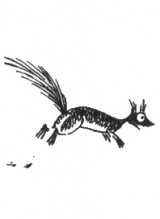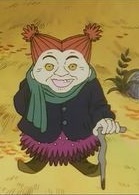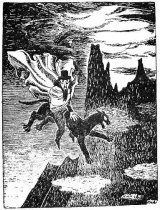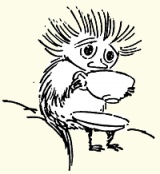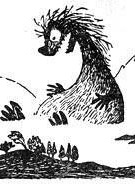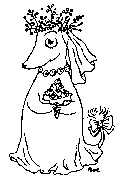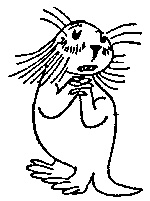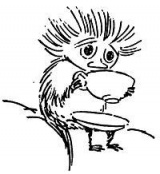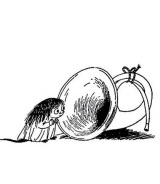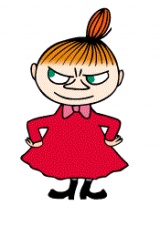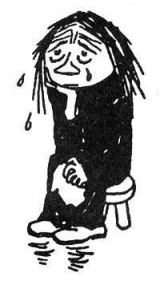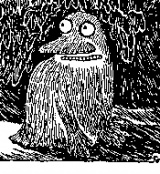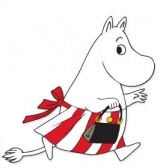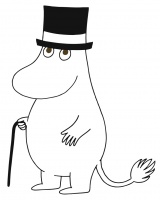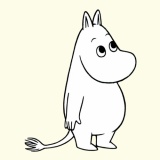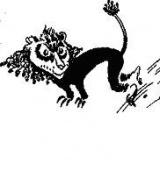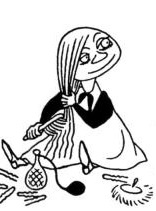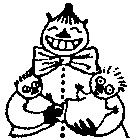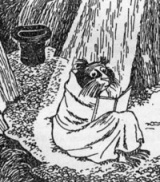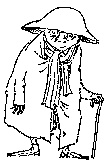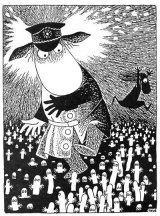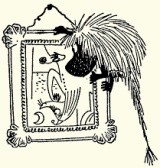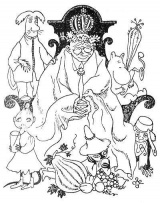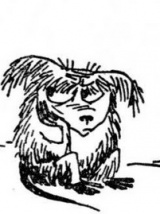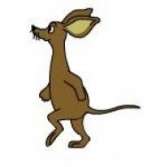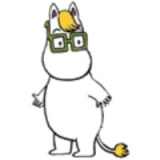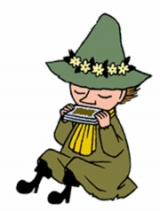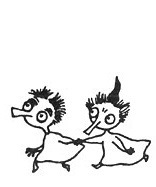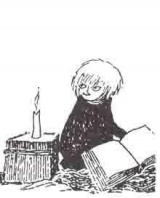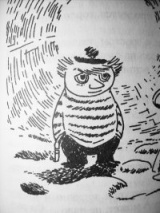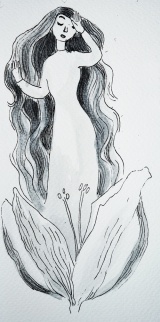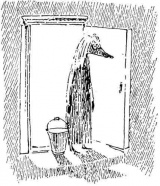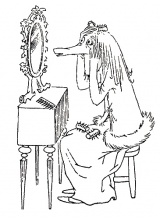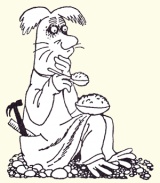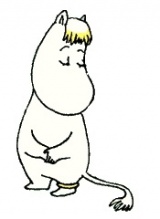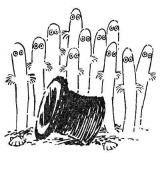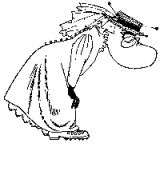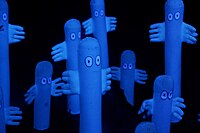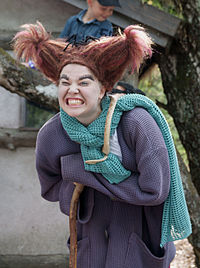Как выглядят муми-тролли
Читая сказки Туве Янссон о муми-троллях, обычно люди воображают удивительно милых существ, которые населяют волшебный мир. Художники изображают их примерно одинаково в мультфильмах или для театра, потому что сама писательница не только описала героев сказки, но и нарисовала их.
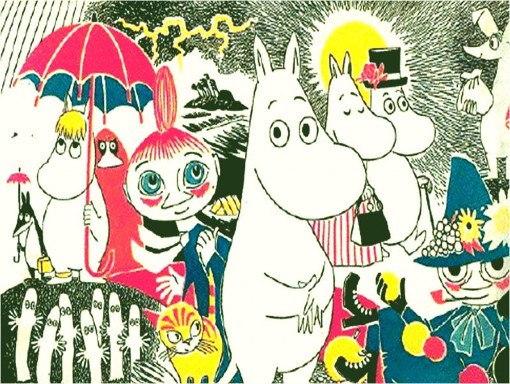
Инструкция
Муми-тролли происходят от страшных скандинавских троллей, но выглядят совсем иначе. Они напоминают формами бегемотов, но намного меньше ростом, белого цвета и ходят на двух задних лапках. На кончике хвоста у них шелковистая кисточка. Кроме того, у них нет огромных зубов и весьма добродушная натура.
Еще до появления знаменитых сказок о муми-троллях Туве Янссон рисовала в качестве подписи зверька, похожего на бегемотика, и называла его снорком. Но он был значительно худее, чем муми-тролли, и имел длинный нос, а его уши больше походили на рога. Со временем этот образ эволюционировал.
Семья главных героев состоит из Муми-тролля, его мамы и папы. Они все очень похожи между собой, но мама всегда носит сумку со всеми необходимыми вещами (сухими носками, конфетами и лекарствами), а папа — шляпу-цилиндр. За печкой у них живет дальний родственник муми-троллей, Домовой, но о его внешнем виде известно лишь, что он не похож на своих потомков.
Ближайшие родственники муми-троллей — снорки. Снорк и его сестра фрекен Снорк дружат с Муми-троллем. Они очень похожи, но снорки умеют менять цвет в зависимости от настроения, а их тело покрыто легким пухом. Фрекен Снорк к тому же отличает пышная челка и золотой браслет на ноге.
Вместе с муми-троллями в волшебной долине живут многочисленные домочадцы. Из вид тоже очень любопытен. Снифф внешне напоминает крысу, особенно вытянутым носом и длинным хвостом, но бегает на задних лапках. Внешность Снусмумрика разглядеть трудно из-за одежды: он носит поношенную зеленую хламиду и остроконечную шляпу с широкими полями, натянутую на глаза. Хемуль намного выше муми-троллей, но похож на них большой головой и маленькими ушами. Обычно носит платье, полученное от тетки.
Войти на сайт
или
Забыли пароль?
Еще не зарегистрированы?
This site is protected by reCAPTCHA and the Google Privacy Policy and Terms of Service apply.
Персонажи
- Будем искать среди персонажей фандома
Алисия
1
0
0
Девочка, внучка ведьмы, живёт в лесу. Упоминается только в японских мультфильмах.
Бельчонок с хорошеньким хвостиком
1
0
1
Маленький забывчивый бельчонок, упоминается в книге «Волшебная зима», где замерзает под взглядом Ледяной девы, а весной оживает.
Ведьма
0
0
0
Бабушка Алисии, живёт в лесу. Упоминается только в японских мультфильмах.
Волшебник
0
3
0
Наделён магической силой, но не может исполнять собственные желания. Волшебник появляется в книге «Шляпа волшебника». Его шляпу Муми-тролль, Снусмумрик и Снифф находят в первой главе. Сам Волшебник впервые упоминается в пятой главе и, наконец, появляется в седьмой. Коллекционировал рубины до того как стал обладателем «короля рубинов».
Гафса
0
4
0
Небольшое существо. Впервые появляется в рассказе «Филифьонка, которая верила в катастрофы». Она также присутствует в рассказе «Ёлка» и упоминается в книге «В конце ноября».
Домовой
0
0
0
Родственник Муми-мамы. Упоминается в книге «Муми-тролль и комета».
Дронт Эдвард
0
0
0
Большой дронт, внешне похож на дракона с большими глазами. Незлобный. Дронт Эдвард впервые появляется в книге «Мемуары папы Муми-тролля» во второй главе. Он также присутствует в рассказе «Хемуль, который любил тишину».
Зверюшка Сос
0
0
0
Мать Сниффа, супруга Шнырька. Присутствует в книге «Мемуары папы Муми-тролля», где появляется впервые в восьмой главе.
Клипдасс
0
0
0
Маленький проворный зверёк с острыми зубами, похожий на выдру. Клипдассы живут на дне водоемов, образуя большие колонии. Поверхность их тел очень липкая, благодаря своей клейкости они могут даже взбираться на отвесные стены. Носят бакенбарды. Присутствуют в книге «Мемуары папы Муми-тролля», впервые появляясь в третьей главе.
Кнютт
0
0
0
Крошечное мохнатое существо, тихое и застенчивое.
Крошка Саломея
0
0
0
Малявка с отважным характером, испытывает симпатию к Хемулю-лыжнику. Присутствует в книге «Волшебная зима», впервые появляясь в пятой главе.
Ледяная дева
0
1
1
Воплощение зимы. Персонаж упоминается в книге «Волшебная зима». Везде, где проходит ледяная дева, наступает самая суровая зимняя пора. Под её взглядом любой зверёк замерзает.
Лесной дух
0
0
0
Бестелесное существо, живёт на деревьях в лесу, часто не поодиночке, а колониями.
Малышка Мю
Little My
5
11
2
Сестра Мюмлы и Снусмумрика, дочь Мюмлы-мамы. Самая маленькая мюмла на свете. Внешне похожа на человека, носит платье, волосы убраны в высокий хвост. Характер независимый, ничего не боится, умеет постоять за себя, сообразительна, самостоятельна. Семейство муми-троллей удочерило её. Малышка Мю впервые появляется в седьмой главе книги «Мемуары папы Муми-тролля». Она также присутствует в книгах «Опасное лето», «Волшебная зима» и «Муми-папа и море»; в рассказах «История о последнем на свете драконе», «Дитя-невидимка», «Ёлка». Малышка Мю упоминается, но отсутствует в книге «В конце ноября», в рассказе «Секрет хатифнаттов».
Мальчик с рыжими волосами
0
0
0
Человек. По размерам соизмерим с муми-троллями. Упоминается в книге «Маленькие тролли и большое наводнение».
Мартышка (Котёнок)
0
0
0
Обитатель муми-дола. Мартышка присутствует в книге «Муми-тролль и комета», впервые появляясь в первой главе. В переводе В.Смирновой — Мартышка, в переводе Н.Беляковой — Котёнок.
Миса
0
2
0
Присутствует в книге «Опасное лето», впервые появляясь во второй главе. Она также упоминается в рассказе «Ёлка».
Морра
12
12
4
Пугающее существо, наводящее ужас на большинство персонажей. Одинокая и холодная. Если Морра просидит час на одном месте, земля под ней промёрзнет настолько, что там никогда ничего не вырастет. Стремится к теплу и свету. Морра впервые появляется в шестой главе книги «Шляпа волшебника». Она присутствует также в книгах «Мемуары папы Муми-тролля», «Волшебная зима» и «Муми-папа и море».
Морская лошадь
0
0
0
Живёт в море, танцует в лунном свете. Копыта подкованы серебряными подковами. Морская лошадь очаровывает Муми-тролля в книге «Муми-папа и море».
Муми-мама
Moominmamma
3
12
0
Мама Муми-тролля, супруга Муми-папы. Носит фартук и сумочку, в которой есть всё необходимое. Аккуратная, хозяйственная, гостеприимная. Воплощает образ идеальной мамы и жены. Присутствует в книгах «Маленькие тролли и большое наводнение», «Муми-тролль и комета», «Шляпа Волшебника», «Мемуары папы Муми-тролля», «Опасное лето», «Волшебная зима» и «Муми-папа и море»; в рассказах «История о последнем на свете драконе», «Дитя-невидимка», «Ёлка», «Секрет хатифнаттов» и «Седрик». Муми-мама упоминается, но отсутствует в книге «В конце ноября».
Муми-папа
Moominpappa
1
8
1
Отец Муми-тролля, супруг Муми-мамы, глава семейства. Сирота, воспитывался в приюте вместе с хемулями. До встречи с Муми-мамой много путешествовал. Построил муми-дом и все сооружения самостоятельно. Обладает исследовательскими и писательскими способностями, любит море. Муми-папа впервые упоминается в книге «Маленькие тролли и большое наводнение», а появляется в книге «Муми-тролль и комета». Он также присутствует в таких книгах как «Шляпа Волшебника», «Мемуары папы Муми-тролля», «Опасное лето», «Волшебная зима» и «Муми-папа и море»; в рассказах «История о последнем на свете драконе», «Дитя-невидимка», «Ёлка» и «Секрет хатифнаттов». Муми-папа упоминается, но отсутствует в книге «В конце ноября».
Муми-тролль
Moomintroll
6
17
9
Главный герой истории, сын Муми-мамы и Муми-папы. Внешний вид: похож на бегемотика или гиппопотама белого цвета, с крупным носом, маленькими ушами и глазами, короткими лапами и хвостом. По возрасту — ребёнок, ближе к подростку. Открытый, дружелюбный, любит приключения. Муми-тролль впервые упоминается в книге «Маленькие тролли и большое наводнение» в первой главе. Он также присутствует в книгах «Муми-тролль и комета», «Шляпа Волшебника», «Мемуары папы Муми-тролля», «Опасное лето», «Волшебная зима» и «Муми-папа и море»; в рассказах «История о последнем на свете драконе», «Дитя-невидимка» и «Ёлка». Муми-тролль упоминается, но отсутствует в книге «В конце ноября», а также рассказах «Седрик» и «Весенняя песня».
Муравьиный лев
0
0
0
Злобный персонаж, живёт в песке. Упоминается в книгах «Маленькие тролли и большое наводнение» и «Шляпа Волшебника».
Мюмла
Mymble
2
4
0
Сестра Малышки Мю, сводная сестра Снусмумрика и дочь Мюмлы-мамы. Намного выше Малышки Мю, внешне похожа на человека, ходит в платье, имеет длинные красивые волосы, которые забирает в хвост. Голова большая. Есть маленький хвостик, но его не видно под одеждой. Она впервые появляется в книге «Мемуары папы Муми-тролля», в пятой главе. Присутствует в книгах «Мемуары папы Муми-тролля», «Волшебная зима», «Опасное лето», «В конце ноября» и в рассказе «История о последнем на свете драконе», упоминается в рассказе «Секрет хатифнаттов».
Мюмла-мама
Mymble
0
0
0
Мать Снусмумрика, Малышки Мю, Мюмлы и ещё бесчисленного множества других мюмл. Мюмла присутствует в книге «Мемуары папы Муми-тролля», впервые появляясь в пятой главе.
Нуммулит
0
0
0
Полувымышленный персонаж из научной книги, которую читал хомса Тофт. Доисторический зверёк, который когда-то был очень маленьким, а затем увеличился и стал проявлять агрессию. Пахнет электричеством. Хомса Тофт оживил Нуммулита и отпустил его на свободу. Упоминается в книге «В конце ноября».
Ондатр
2
1
0
Ондатр (он же Выхухоль) — философ. Впервые появляется в первой главе книги «Муми-тролль и комета», также присутствует в книге «Шляпа Волшебника».
Онкельскрут
0
1
0
Родственник муми-троллей. Онкельскрут появляется только в книге «В конце ноября» в первой главе как «старческий голос», разговаривающий со Снусмумриком, присутствует в повествовании с седьмой главы. Стар (около 100 лет). Онкельскрут — не настоящее его имя (настоящее он забыл, выдумал себе новое).
Пожилой Господин
0
0
0
Человек. Упоминается в книге «Маленькие тролли и большое наводнение»
Полицейский Хемуль
0
2
1
Арестовывает Муми-тролля и его друзей в книге «Опасное лето». Впервые появляется в седьмой главе.
Предок
0
1
0
Предок муми-троллей, живёт в печи в муми-доме. Покрыт шерстью. Упоминается в книге «В конце ноября».
Профессор
0
1
0
Профессора работают в обсерватории в Одиноких Горах, изучают звёзды, много курят. Предсказали точное время появления кометы в книге «Муми-троль и комета».
Рыбак (Хранитель маяка)
0
0
0
Рыбак, он же Хранитель маяка, присутствует в книге «Муми-папа и море», где он появляется во второй главе. Небольшого роста, старый, худой. День рождения 3 октября, точный возраст неизвестен.
Самодержец
0
0
0
Человек, владеет островом, любит эффектные зрелища. Упоминается в «Мемуарах Муми-папы» (глава 5).
Скротт
0
0
0
Маленький зверёк с рожками.
Снифф
Sniff
3
3
0
Друг Муми-тролля, сын зверька Шнырька и зверюшки Сос. Внешне похож на крысёнка, маленького роста, с длинным хвостом. Младше Муми-тролля. Живёт в отдельном домике рядом с муми-домом, часто гостит у муми-семьи. Немного труслив и капризен. Снифф с самого начала появляется под именем Маленький Зверёк в книге «Маленькие тролли и большое наводнение». Присутствует в книгах «Муми-тролль и комета», «Шляпа Волшебника», «Мемуары папы Муми-тролля», в рассказе «Седрик».
Снорк
The Snork
1
2
0
Друг муми-семьи, старший брат Фрекен Снорк. Внешне похож на муми-троллей, но меняет окрас в зависимости от настроения. Изобретатель, педант. Впервые упоминается в книге «Муми-тролль и комета» в шестой главе, а появляется сам в седьмой главе. Он присутствует также в книге «Шляпа Волшебника».
Снусмумрик
Snafkin
25
11
2
Лучший друг Муми-Тролля, сын Мюмлы-мамы и Юксаре. Внешне похож на человека, возраст ближе к подростковому. Первая встреча с Муми-Троллем — книга «Муми-тролль и комета». С тех пор лето проводит в Муми-доле, а на зиму отправляется в путешествие на юг. Он также присутствует в книгах «Шляпа Волшебника», «Мемуары папы Муми-тролля», «Опасное лето» и «В конце ноября»; в рассказах «История о последнем на свете драконе» «Весенняя песня», «Седрик» и «Секрет хатифнаттов». Снусмумрик упоминается, но отсутствует в книге «Волшебная зима». Живёт в палатке, играет на губной гармошке, курит трубку, умеет рассказывать интересные истории и сочинять песни. Независимый, любит одиночество. Ненавидит запрещающие объявления и сторожей.
Прототипом этого персонажа является финский журналист и политик Атос Казимир Виртанен, друг Туве Янссон.
Стинки
0
0
0
Появляется только в мультсериале «Муми-тролль». Отрицательный персонаж.
Тофсла и Вифсла
1
1
1
Неразлучная парочка, «иностранцы» (говорят на чужеродном для обитателей муми-дола наречии, добавляя к словам окончание -сла). Маленького роста, пугливые. Присутствуют в книге «Шляпа волшебника», впервые появляясь в шестой главе.
Тофт
1
1
0
Маленький зверёк с развитым воображением, очень любит Муми-маму. До появления в муми-доле жил в лодке Хемуля. Хомса Тофт присутствует в книге «В конце ноября», впервые появляясь в первой главе.
Туу-тикки
3
8
0
Зимой живёт в купальне в муми-доле. Появляется в книге «Волшебная зима» и в рассказе «Дитя-невидимка».
Тюлиппа
0
0
0
Девочка с длинными ярко-голубыми распущенными волосами, человек. Присутствует только в книге «Маленькие тролли и большое наводнение». Прекрасно воспитана. Осталась жить с Рыжим Мальчиком с маяка.
Филифьонка
1
9
2
Филифьонка любит порядок и не любит насекомых. Очень хозяйственная. Не любит родственников. Высокая, худощавая, мордочка вытянутая, похожая на собачью. Впервые появляется в рассказе «Филифьонка, которая верила в катастрофы» а также присутствует в книге «В конце ноября». Также некая филифьонка упоминается в пятой главе «Опасного лета».
Филифьонка (племянница Эммы)
0
3
1
Филифьонка, которая является племянницей театральной крысы Эммы, присутствует в книге «Опасное лето», впервые появляясь в седьмой главе.
Фредриксон
0
0
0
Старый друг Мумии-папы. Присутствует в книге «Мемуары папы Муми-тролля», впервые появляясь в первой главе. Изобретатель, строитель и капитан парохода «Морской Оркестр».
Фрекен Снорк
Snork Maiden
2
4
5
Подруга Муми-тролля, сестра Снорка. Внешне похожа на муми-троллей, но меняет цвет при изменении настроения, покрыта тоненьким мягким пухом и имеет пушистую мягкую чёлку. Носит на ноге золотой бласлет. Хозяйственна, сообразительна, питает симпатии к Муми-троллю. Впервые упоминается в книге «Муми-тролль и комета» в шестой главе, а появляется сама в седьмой главе. Она присутствует также в книгах «Шляпа Волшебника», «Опасное лето», «Волшебная зима»; в рассказах «История о последнем на свете драконе», «Ёлка».
Хатифнатты
2
1
1
Вечные странники, небольшие белые существа без лиц, глаза всегда смотрят вдаль, ничего не говорят и не слышат, не имеют органов дыхания и пищеварения. могут осязать, орган осязания находится у них в животе. Видят плохо. Умеют читать мысли. Питаются электричеством, наэлектризованные светятся и бьются током.. Появляются на свет из семян в день летнего солнцестояния. Путешествуют в маленьких лодочках по всему свету. Раз в год собираются на своем тайном острове. Впервые упоминаются и появляются в книге «Маленькие тролли и большое наводнение» — по словам Муми-мамы именно с ними отправился путешествовать Муми-папа и исчез. Они присутствуют также в книгах «Муми-тролль и комета», «Мемуары папы Муми-тролля», «Шляпа волшебника» и «Опасное лето», а также в рассказе «Секрет хатифнаттов».
Хемулиха-директриса
0
0
0
Директриса приюта, где рос Муми-папа. Присутствует в книге «Мемуары папы Муми-тролля» и впервые появляется в первой главе.
Хемуль
1
3
0
Описание от Муми-папы:
«Хемули достигают почти двойной высоты обычного папоротника. У них вытянутые и немного угнетенные лица. Розовые глаза. Нет ушей, но вместо них несколько пучков синих или цвета имбиря волос. Хемули — вовсе не выдающиеся интеллектуалы и легко становятся фанатиками. Их ноги ужасно большие и плоские. Они не могут научиться свистеть, и поэтому не любят любой свист».
Хемули живут в муми-доле и других местах, упоминаются почти во всех книгах и рассказах.
Здравствуйте! Моя «Сказка в коробочке» пополнилась новыми персонажами. В этот раз речь пойдет о героях финской писательницы Туве Янссон.(очень много фото!)
Туве Марика Янссон (швед. Tove Marika Jansson, 9 августа 1914 — 27 июня 2001) — финская писательница (правда, писала на шведском языке), художница, потомственный иллюстратор. Стала знаменитой благодаря своим книгам о муми-троллях.
Чуть ли не с 10 лет Янссон стала иллюстратором популярного детского журнала, главным редактором которого была хорошая знакомая родителей.
Всемирная известность к Янссон пришла благодаря иллюстрированному книжному сериалу о муми-тролля. Муми-тролли — это очаровательные существа, обитающие в идиллической Муми-долине. Книги били все рекорды по популярности в 1950-60-е годы. Они расходились многомиллионными тиражами и издавались по всему миру. Например, «Шляпа волшебника» была переведена на 34 языка.
Слово «муми-тролль» появилось в 1930-е, когда Туве училась в Стокгольме и жила у своего дяди Эйнара Хаммерштена. Тот рассказывал ей о неприятных и пугающих «му-у-умитроллях», которые живут за печкой и охраняют его еду от ночных набегов племянницы. Они издают протяжные вздохи — отсюда название. С тех пор в дневниках Янссон стала использовать слово «муми-тролль» для обозначения чего-то ужасного или пугающего. Однако в какой-то момент писательница обратилась к собственным детским страхам и постепенно приручила их, а затем по-настоящему полюбила.
Всего о муми-троллях Янссон написала 8 повестей («Маленькие тролли и большое наводнение», «Муми-тролль и комета», «Шляпа волшебника», «Опасное лето», «Мемуары Муми-папы», «Волшебная зима», «Папа и море», «В конце ноября»), один сборник рассказов «Дитя-невидимка», 4 книжки в картинках («Опасное путешествие», «А что потом», «Кто утешит малютку», «Мошенник в доме Муми-троллей»).
В виде комиксов мумии-тролли появились впервые в 1954 году.
Рисовать комиксы Янссон помогал ее брат Ларс, который впоследствии придумывал и рисовал муми-комиксы на протяжении 20 лет, превратив их в очень доходный бизнес.
Еще интересный факт. По творчеству Янссон было защищено множество диссертаций, её сказки подвергались семиотическому и психоаналитическому анализу.
Итак, в основе художественного мира Туве Янссон лежит образ дома — дома, в котором всегда горит свет, тебя ждут близкие, готова вкусная еда и тёплая постель. Как например, Муми-мама спокойно дожидается окончания затянувшихся странствий Муми-тролля за накрытым столом («Комета прилетает»).
Указываются и другие мотивы творчества Туве Янссон, такие как свобода, тема одиночества.
Истории про мумии-троллей, что важно, заставляют задуматься и детей, и взрослых. В детстве одной из моих настольных книг был вот этот сборник сказочных повестей скандинавских писателей. Я обожала очаровательных персонажей Туве Янссон, принимая их такими, какие они есть, на уровне своего детского восприятия.
В более взрослом возрасте стал нравиться кукольный мультфильм про мумии-троллей.
Не могу сказать, что являюсь поклонницей творчества Янссон и самих мумии-троллей. Но они – часть моего детства. И в этом их ценность.
В своем проекте задействовала не всех героев, а наиболее значимых для меня.
Вначале появились крошечные фигурки. С них все и началось.
А потом я обратилась к знакомым талантливым мастерам, которые и создали муми-персонажей в рамках моего любимого формата 1:12.
Теперь немного о самих муми-героях.
Муми-дом в Муми-долине.
«…В конце концов они пришли в маленькую долину. Красивее им в тот день видеть ничего не довелось. И там, посреди зеленого луга, стоял дом, сильно напоминавший печь, очень красивый дом, выкрашенный голубой краской.
— Это же мой дом! — вне себя от радости воскликнул папа. — Он приплыл сюда и стоит теперь здесь, в этой долине!»
Муми-долина — классическая европейская пастораль, уединенное место на лоне природы, которое делает героя мудрее и счастливее.
Муми-тролль (работа Галины с ЯМ)
Moomintroll
Главный герой истории, сын Муми-мамы и Муми-папы. Внешний вид: похож на бегемотика или гиппопотама белого цвета, с крупным носом, маленькими ушами и глазами, короткими лапами и хвостом. По возрасту — ребёнок, ближе к подростку. Открытый, дружелюбный, любит приключения. Общий любимец, подкупающе искренний, отзывчивый, любит родителей и друзей. Он с удовольствием, как и любой другой ребёнок, пускается во всевозможные путешествия и ищет приключения; всегда жаждет чего-то нового, невиданного, таинственного и необыкновенного. Иногда маленькому Муми-троллю кажется, что время замедляется, а мысли растут — но это растёт он сам. Вообще Муми-тролль смел, но иногда робок. Легко заводит новые знакомства, чем причиняет беспокойство своей маме.
Муми-мама (работа Натальи – с ЯМ)
Moominmamma
Мама Муми-тролля, супруга Муми-папы. Идеальная мама и жена, воплощение доброты, нежности, заботы. Она всё всем разрешает. Всегда готова принять у себя в доме новую «порцию» друзей своего любимого сына, накормить, окружить вниманием и уложить спать всю эту ораву. Носит фартук и сумочку, в которой, впрочем, не носит ничего особенного, только вещи, которые могут вдруг понадобиться: сухие носки, леденцы, порошки от желудка. Аккуратная, хозяйственная, гостеприимная.
Муми-папа (работа Натальи – с ЯМ)
Moominpappa
Отец Муми-тролля, супруг Муми-мамы, глава семейства. Муми-папа встретил Муми-маму, когда море во время шторма принесло её прямо к нему в объятия.
Муми-папа — родился при неповторимом положении звёзд и был оставлен в Доме для подкидышей тётки Хемулихи. До встречи с Муми-мамой много путешествовал. Построил Муми-дом и все сооружения самостоятельно. Верен своим привычкам, способен на отчаянные поступки, любит всё необычное. Считает себя одарённым, но непонятым. Обладает исследовательскими и писательскими способностями, любит море.
Снифф (работа Елены с ЯМ)
Sniff
Снифф — друг Муми-тролля, длиннохвостый зверёк, вроде крысёнка. Сын зверька Шнырька и зверюшки Сос и внучатый племянник Фредриксона. Внешне похож на крысёнка, маленького роста, с длинным хвостом. Младше Муми-тролля. Живёт в отдельном домике рядом с муми-домом, часто гостит у муми-семьи.
Капризен, труслив, немного жадный, склонен к занудству. Как сорока, любит всё яркое и блестящее. Нашёл свой грот (хоть и не совсем самостоятельно), о чём неустанно повторяет всем окружающим. Любит существ ещё меньше себя. Любимая фраза: «Это приключение может быть опасно для такого маленького зверька, как я». Очень дорожит своим хвостом.
Фрекен Снорк (работа Галины с ЯМ)
Snork Maiden
Фрёкен Снорк — сестра Снорка, подружка Муми-тролля. Предмет его влюбленности. Внешне похожа на муми-троллей, но меняет цвет при изменении настроения, покрыта тоненьким мягким пухом и имеет пушистую мягкую чёлку и носит золотой браслет на ноге (её естественный цвет, в отличие от брата, — светло-зеленый). Очень кокетлива, любит украшения и проводит много времени перед зеркалом. Очень сообразительна. Хозяйственна, питает симпатии к Муми-троллю.
Снорк (работа Натальи с ЯМ)
The Snork
Снорк — внешне очень похож на Муми-тролля, но, как и все снорки, меняет свой цвет в зависимости от настроения (естественный цвет — бледно-фиолетовый). Друг муми-семьи, старший брат Фрекен Снорк. Изобретатель, педант.Любит во всём наводить порядок и проводить собрания по любому поводу. Очень серьёзный и слегка заносчивый. Мечтает придумать «вычислительную машину, такую, чтобы решала… что хорошо, а что дурно».
Хемуль (работа Елены с ЯМ)
Хемуль — один из самых образованных жителей Долины. Довольно занудный, но в принципе добродушен, если его не злить. Любит командовать и никогда не признаёт своей неправоты. Собирает почтовые марки и растения. Ходит в платье, которое ему досталось в наследство от тётки, в качестве приветствия использует книксен. Имеет многочисленных родственников (один из них, коллекционирующий бабочек, появляется в книге «Муми-тролль и комета»; другой, увлекающийся слаломом и лыжным спортом вообще, — в книге «Волшебная зима»).
Описание от Муми-папы:
«Хемули достигают почти двойной высоты обычного папоротника. У них вытянутые и немного угнетенные лица. Розовые глаза. Нет ушей, но вместо них несколько пучков синих или цвета имбиря волос. Хемули — вовсе не выдающиеся интеллектуалы и легко становятся фанатиками. Их ноги ужасно большие и плоские. Они не могут научиться свистеть, и поэтому не любят любой свист».
Малышка Мю и Мюмла (работа Елены с ЯМ)
Малышка Мю
Little My
Сестра Мюмлы и Снусмумрика, дочь Мюмлы-мамы. Самая маленькая мюмла на свете. Внешне похожа на человека, носит платье, волосы убраны в высокий хвост. Характер независимый, ничего не боится, умеет постоять за себя, сообразительна, самостоятельна. Семейство муми-троллей удочерило её.
Малышка Мю — самая маленькая мюмла на свете (по размеру, но не по возрасту). Ехидная и насмешливая, но не злая. Не умеет грустить, может только радоваться или сердиться. Любит шум.
Мюмла
Mymble
Сестра Малышки Мю, сводная сестра Снусмумрика и дочь Мюмлы-мамы. Намного выше Малышки Мю, внешне похожа на человека, ходит в платье, имеет длинные красивые волосы, которые забирает в хвост. Голова большая. Есть маленький хвостик, но его не видно под одеждой.
Мюмла — серьёзная девушка, стремится к самостоятельности и независимости. Любит свои роскошные волосы, которые она всё время расчёсывает. Пытается (без особого успеха) воспитывать свою младшую сестру Мю.
Снусмумрик (работа Елены с ЯМ)
Snafkin
Снусмумрик — лучший друг Муми-Тролля, сын Мюмлы-мамы и Юксаре. Внешне похож на человека, возраст ближе к подростковому. Лето проводит в Муми-доле, а на зиму отправляется в путешествие на юг. Живёт в палатке, которую всегда носит в своем рюкзаке., играет на губной гармошке, курит трубку, умеет рассказывать интересные истории и сочинять песни. Независимый, любит одиночество. Ненавидит запрещающие объявления и сторожей.
Знает всех птиц и животных. Неутомимый путешественник и искатель приключений, Ненавидит запрещающие таблички и сторожей. Равнодушен к собственности.
Тофсла и Вифсла (работа Натальи с ЯМ)
Тофсла и Вифсла — два маленьких юрких создания неопределённого пола (в оригинале были девочками, в некоторых переводах стали мальчиками). Неразлучная парочка, «иностранцы» (говорят на чужеродном для обитателей муми-дола наречии, добавляя к словам окончание -сла). Маленького роста, пугливые. Никогда не расстаются со своим большим чемоданом. Любят молоко и содержимое своего чемодана.
И, конечно же,Морра!
Морра (швед. Mårran, фин. Mörkö).
Это единственный персонаж, который я решила взять на себя. Мои таланты, к сожалению, лежать за гранью рукотворчества.
Морра пока единственная, кого я создала собственными руками. Последняя попытка предпринималась лишь в глубоком детстве.
Вот такая она у Туве Янссон:
Вначале Морра выступает как отрицательный сюрреалистический персонаж, который преследует корыстные цели. Но на самом деле она ищет тепла и дружбы. Она символизирует одиночество.
Однако вскоре Муми-тролль заводит своеобразные отношения с Моррой: каждый вечер он приходит на берег и включает фонарь, пока Морра поёт и танцует, придерживая свои юбки. Постепенно Муми-тролль понимает, что Морра приходит не ради огня фонаря, а ради него. Он также понимает, что Морра ему стала отчасти близка. Отношения с Муми-троллем помогают Морре избавиться от одиночества, и земля перестает замерзать под ней.
Еще был персонаж, который мне понравился в нашем кукольном мультфильме. Это Ондатр. Но его я не стала воссоздавать. Пусть остается неким эфемерным созданием.
С детства запомнилась его фраза: «Вся жизнь бренна…». Здесь меня больше радовала реакция Сниффа, который с умным видом повторил эту фразу за Ондатром, а потом с наивным видом спросил: «А что такое «бренна»?» Именно со Сниффом я себя тогда и ассоциировала…
Ондатр (он же Выхухоль) — философ. Впервые появляется в первой главе книги «Муми-тролль и комета», также присутствует в книге «Шляпа Волшебника».
Ондатр (в переводе Брауде и Беляковой его зовут Выхухоль) — очень много «философствует» и любит, чтобы другие за ним ухаживали. Читает толстую книгу под названием «О ненужности всего сущего» (в некоторых переводах — «О тщете всего Сущего») и ожидает конца света.
Таким образом собралась моя компания персонажей сказочного Муми-дола. И возник вопрос, куда же их поселить.
Дом муми-троллей полон ненужных мелочей, там далеко не всегда прибрано, зато каждому найдется уголок. Над созданием модели Муми-дома Туве Янссон работала вместе с Тууликки Пиетиля, и этот макет до сих пор сохранился в музее, посвященный мумии-троллям в Тампере (Финлядния)
Кроме того, есть книга «Мошенник в Муми-доме», иллюстрации к которой является интерьер этого дома.
Описание обстановки в доме не совсем соответствует его модели в музее, но здесь это несущественно. Хотя сравнить очень интересно.
Например, описание комнаты Муми-папы.
«Однажды в сумерках хемуль прокрался в папину комнату и почтительно остановился в дверях. Это было небольшое помещение со скошенным потолком — прекрасное место для уединения. Голубые стены комнаты украшали ветки странной формы, на одной стене висел календарь с изображением разбитого корабля, а над кроватью была помещена дощечка с надписью: „Хайг. Виски“.
На комоде лежали забавные камешки, золотой слиток и множество всяких мелочей, которые оставляешь, если собираешься в дорогу. Под зеркалом стояла модель маяка с остроконечной крышей, маленькой деревянной дверью и оградой из латунных гвоздей под фонарем. Тут был даже переносной трап, который Муми-папа сделал из медной проволоки. В каждое окошечко он вклеил серебряную бумажку.»
И фото из книги и музея, найденные на просторах Интернета.
Комната Муми-мамы:
«Впервые вошел хомса Тофт в мамину комнату. Она была белая. Он наполнил умывальник водой и поправил вязаное покрывало. Вазу Филифьонки он поставил на ночной столик. На стенах здесь не было никаких картин, и на комоде не было ничего, кроме блюдечка с иголками, резиновой пробки и двух круглых камешков. На подоконнике хомса нашел складной нож. „Она забыла его, — подумал он, — этим ножом она вырезала лодочки из коры.“
Гостиная.
»Хомса робко оглядывал красивую и строгую комнату. Мебель была великолепная, стулья обиты темно-красным бархатом, а на спинке каждого из них была кружевная салфетка. Хомса не посмел сесть. Кафельная печь доходила до самого потолка. Кафель был разрисован сосновыми шишками, шнурок заслонки расшит бисером, а печная дверца была из блестящей латуни. Комод тоже был блестящий — полированный, с золочеными ручками у каждого ящика.
— Ну, так что же ты не садишься? — спросил хемуль.
Хомса присел на самый краешек стула и уставился на портрет, висевший над комодом. Из рамы на него глядел кто-то ужасно серый и косматый, со злыми, близко посаженными глазами, длинным хвостом и огромным носом.
— Это их прадедушка, — пояснил хемуль. — В ту пору они еще жили в печке.»
Такие роскошные апартаментов воссоздать при всем своем желании у меня не получилось бы. К тому же это «Сказка в коробочке», поэтому интерьер не должен занимать много места.
Выход был найден. Как-то на распродаже купила деревянный декоративный фонарь. Покрасила его в синий цвет, крышу – в красный.
Внутрь провела свет (использовала гирлянду на батарейках). Теперь этот фонарь можно использовать и в качестве ночника.
В небольшом мультфильме, который выложу в конце данного поста, можно будет увидеть, как изменяется интерьер под конкретного жителя.
Обстановка набиралась из имеющейся мебели.
Комната Муми-папы.
Комната Муми-мамы
Комната Муми-тролля и Сниффа.
Кстати, так она выглядит со светом и без.
Комната Фрекен Снорк.
Гостиная.
В гостиную повесила портрет прадедушки мумии-тролля. «Из рамы на него глядел кто-то ужасно серый и косматый, со злыми, близко посаженными глазами, длинным хвостом и огромным носом».
За основу взяла изображение мумии-тролля из советского диафильма, поэтому прадедушка получился вот такой:
Для своих героев распечатала фоны, чтобы все выглядела более естественно (если так можно сказать). Заодно использовала их в качестве декораций к своему мультфильму.
Предлагаю посмотреть эти картинки и заодно вспомнить цитаты из книги про муми-троллей.
«Можно лежать на мосту и смотреть, как течет вода. Или бегать, или бродить по болоту в красных сапожках, или же свернуться клубочком и слушать, как дождь стучит по крыше.
Быть счастливой очень легко.»
Никогда не станешь по-настоящему свободным, если будешь чрезмерно кем-нибудь восхищаться.
Мы должны держать глаза открытыми и видеть, когда стоим на распутье, ведь столько дорог на нашем пути: тропинки, боковые дорожки, разные возможности.
Иногда ужасно тяжело быть самим собой.
Быть коллекционером гораздо веселее, чем быть владельцем.
Ваши планы не обязательно должны быть необычайными, чтобы сделать вас необычайно счастливыми.
В большинстве случаев конец — это начало!
Каждый нуждается в тепле и свете, даже Морра.
О, как это прекрасно — наконец стать старым и выйти на пенсию! — думал Хемуль. — О, как я люблю своих родственников. Особенно теперь, когда могу о них больше не думать
Ночью может быть либо страшно, либо волшебно, в зависимости от компании.
Иногда тайна намного удобней, чем знание ответов на вопросы.
Каждый, вне зависимости от того, мал он или нет, имеет право иногда сердиться.
Не стоит волноваться. В мире нет ничего страшнее нас самих
Я полагаю, что каждое полотно, натюрморт, ландшафт, все что угодно — в самой глубине души автопортрет.
Смотреть на вещи — одно, а держать их в руках, знать, что они твои собственные, — совсем другое.
Тот, кто ест блины с вареньем, не может быть так уж жутко опасен.
Даже самые грустные вещи перестают быть самыми грустными, если относиться к ним правильно.
Каждый человек должен совершить свои ошибки.
Никогда не крась вещи только потому, что у тебя осталась краска.
Зимы всегда довольно тяжёлые. Но, тем не менее, снег — это волшебство.
В обыденной жизни от гениев – одни неприятности.
Днём лишь прогуливаются, но путешествуют ночью.
Чувства сложны и не всегда имеют смысл.
Люди с деньгами иногда пытаются указывать вам, что делать… но у них нет цветов.
Товарищ может говорить тебе ужасные вещи, но назавтра все забыто. Товарищ не прощает, он только забывает, а женщина — она все прощает, но не забывает никогда
На самом деле обо всем можно сочинить песню.
Вам нужны друзья, а не вещи, чтобы иметь дом.
Когда у тебя возникает желание что-то сделать, нужно немедленно принимать решение и не ждать, пока это настроение пройдёт.
Ужасно, как подумаешь, что все великие люди умерли! Александр Македонский, Наполеон и все остальные… Да и мне что-то нездоровится.
А вот и финальная фотосцена:
Не сразу заметила, что кое-кого здесь не хватает…
В мультфильме пришлось данную сцену обыграть, чтобы не обидеть нечаянно забытого персонажа.
В заключении хочу сказать, что приобрела книжку «Муми-тролль и конец света. Самый первый комикс Туве Янссон о муми-троллях»
История в картинках «Муми-тролль и конец света» публиковалась в газете Ny Tid в 1947-1948 годах и в оригинальной форме излагает сюжет о космической угрозе миру и чудесном его спасении.
И мультфильм, сделанный уже с моими персонажами:
Спасибо, что зашли!
Купить авторскую куклу можно в Шопике
Some of the many Moomin characters. From left to right, Sniff, Snufkin, Moominpappa, Moominmamma, Moomintroll (Moomin), Mymble, Groke, Snork Maiden and Hattifatteners.
A large number of characters appear in the Moomin series by Tove Jansson. The original Swedish names are given with the etymologies and word associations suggested by Yvonne Bertills in her 2003 dissertation.[1]
Alicia[edit]
(Swedish: Alissa, Finnish: Aliisa) – Alice, the Witch’s granddaughter, likes the Moomins and plays with them on the sly whenever the Witch is otherwise occupied. She is a witch-in-training herself, and develops several magic skills during the series, most notable walking on water, underwater-breathing, and running at lightning speed. Like the Witch, she first appeared in the 1990 animated series and does not appear in the original stories or comic strips.
Anthony[edit]
Anthony is Nanna’s Groom
The Ancestor[edit]
(Swedish: Förfadern, Finnish: Esi-isä) – the Moomintrolls descend from ancient creatures living in tiled stoves. One of those is still dwelling in the Moomin family’s bathing house cupboard and stove. He is called the Ancestor and makes appearances in Moominland Midwinter and Moominvalley in November.
Aunt Hemulen[edit]
Aunt Hemulen appears only in the 1990 edition, in Episode 4 of Season 2.
Aunt Jane[edit]
Billy The Kid[edit]
Billy The Kid appears only in the 1990 edition, in Episode 17 of Season 2. He lives in «Cowboy Country». He is based on the real outlaw with the same name.
Daddy Jones[edit]
(Swedish: Kungen/Självhärskaren, Finnish: Itsevaltias) – the Autocrat in «Exploits». He owns a fairground full of surprises, sits on a throne and gives a blast on his foghorn when he makes royal proclamations.
Dame Elanie[edit]
The Dweller Under the Sink[edit]
(Swedish: den som bor under diskbänken) – a small furry creature that lives under the sink in Moomin House. He only appears in Moominland Midwinter and becomes known to Moomintroll when he wakes up during the long winter hibernation undertaken by the whole Moominfamily. Moomintroll tries to strike up a conversation with him by complimenting on his rather bushy eyebrows, but only succeeds in upsetting him.
Edward the Booble[edit]
(Swedish: dronten Edward – dronten, «dodo», Finnish: drontti Edvard) – a gigantic monster (the second largest creature in the world – only his brother is larger) who pays for people’s funerals if he accidentally treads on them. He is generally bad tempered because of this. He accidentally aids the launch of the Oshun Oxtra (Ocean Orchestra), a boat invented by Moominpappa’s childhood friend, Hodgkins, by sitting in a river bed.
Emma[edit]
(Swedish) – the rather bitter stage rat (teaterråtta). She helps the Moomin family understand what a theater is and also collaborates with Moominpappa on his play, The Lion’s Brides. Before she introduces herself, the family refers to her as Theprop (the prop) after a misunderstanding.
Fillyjonk[edit]
(Swedish: Filifjonkan – no semantic meaning, but with the first element compare filibuffare «joker», filidera, «make bad noise», and with the second, fjompa/fjanta/fjolla + -an = «silly/foolish/fussy woman») – known as The Fillyjonk in some English translations, the first we hear of is the late theatre director in Moominsummer Madness (the Rat is his widow) and the young Fillyjonk who joins the Snork Maiden in the late night jaunt to the wishing well. Later we meet the wonderful psychological study of the «Fillyjonk Who Believed In Disasters» in Tales from Moominvalley. Not a single moment of fantasy or joy, only duties and discipline; she is an extremely methodical person tied down with principles and has a deep rooted belief in prestige and tradition. Nevertheless, after a catastrophe, The Fillyjonk can be freed from the trammels of social expectation and can discover the joys of freedom, irrationality and self-expression. Deep inside she has had a wish to live freely as the Moomin family does, without any worries. Fillyjonks resemble humanoid rodents; they are tall and thin, with long muzzles and raccoon-like rings around their eyes.
Fuzzy[edit]
(Swedish: Sås-djuret – såsa, «to linger; to loiter» + djur, «animal», Finnish: Sosuli) – Sniff’s mother. Married to Muddler.
Gaffsie[edit]
(Swedish: Gafsan – gafsa, «chatter; tittle-tattle», Finnish: Louska) – not much is known about Gaffsie, except that she is a friend of Fillyjonk. She appears most prominently in The Book about Moomin, Mymble and Little My as well as in Tales from Moominvalley in the stories «The Fillyjonk who Believed in Disasters» and «The Fir Tree». She is also mentioned in Moominvalley in November.
Grandpa Grumble[edit]
(Swedish: Onkelskruttet – onkel, «uncle,» also used in the meaning «grandfather»; for the second element, see under Miffle, Finnish: Ruttuvaari) – an old man who appears in Moominvalley in November. He is quite old and somewhat senile. He uses a cane and owns many pairs of glasses that he carries with him in a basket.
The Groke[edit]
(Swedish: Mårran – morra «to growl; to grumble», Finnish: Mörkö – «bogeyman; bugbear») – cold and ghost-like, she represents loneliness and all that is scary in the world of Moomin.
Hattifatteners[edit]
(Swedish: hattifnattar – with the first element compare hatta, «dither»; the second element is related to fnatta (omkring), «flutter around»; få fnatt, «go crazy or get excited over something»; poss. fnatt, «squirrel») – small white ghost-like creatures that resemble worn socks. Hattifatteners are always on the move and travel the sea in large groups (but always in odd numbers), such as boat convoys. They meet every year on a lonely island.[2] Their only goal in life is to reach the horizon. They may communicate using telepathy. The Hattifatteners cannot see very well, but their sense of touch is very strong, and they can feel ground vibrations and electricity. Hattifatteners assemble once a year when they «recharge» in a thunderstorm, when they can cause electrical burns. Hattifatteners grow from seeds, but only if this seed is sown on Midsummer Eve.
Hemulens[edit]
Hemulen in Moomin World theme park, Naantali, Finland.
(Swedish: Hemul – hemul, a legal term, «authority or warrant for something (n.), entitled (adj.)») (In Swedish «Hemulen» means «the hemul») – Hemulens feature frequently in the books. One of them is an avid stamp collector, and another is an avid skier. A female Hemulen raised Moominpappa in an orphanage, and later Moominpappa met her aunt, who looked confusingly like her. Other characters frequently find the Hemulens annoying or overwhelming, as they can be somewhat loud, bossy, abrasive and insensitive, but they are well-intentioned and usually have other redeeming qualities. In the beginning of Finn Family Moomintroll, a hemulen who is a keen stamp collector is depressed, as he has every stamp on the face of earth and has lost his purpose in life. Later on, he finds a new purpose: to collect plants. In Finn Family Moomintroll, «un-Hemulenish» (ohemul) contains a sense of «unwarranted, unjustified».
The Hobgoblin[edit]
(Swedish: Trollkarlen – «The Wizard») – appearing in Finn Family Moomintroll (Swedish: Trollkarlens hatt), he is a powerful magician who travels the Universe with his flying panther, looking for the King’s Ruby. His top hat is found in the Lonely Mountains by Moomintroll, Snufkin and Sniff, who take it back to Moominhouse. Chaos ensues, as anything you put inside the hat is transformed. Moomintroll himself is changed into a strange creature by the hat when he uses it to hide in during a game. The hat also changes the Moominhouse into a sort of jungle. The Hobgoblin has a quite intimidating appearance, but is friendly.
Hodgkins[edit]
(Swedish: Fredriksson – «Frederickson», a common family name) – an inventor and childhood friend of Moominpappa (The Exploits of Moominpappa). He is Muddler’s uncle and thus Sniff’s great-uncle. He builds the Oshun Oxtra (misspelling of Ocean Orchestra in English, known as Haffsårkestern in Swedish), a boat in which Moominpappa and his friends travel on their adventures.
Hodgkins is called Frederickson in some translations, such as the 1990 animated series.
The Island Ghost[edit]
(Swedish: Spöket – «The Ghost») – a spectre that haunts the Island colonised by Moominpappa in «The Exploits of Moominpappa». He is not very good at haunting and gets annoyed when the colonists laugh at him. He takes up knitting to soothe his nerves.
Joxter[edit]
(Swedish: Joxaren, Finnish: Juksu) – The Joxter is Moominpapa’s old friend and father of Snufkin. He is described as worry-free, cat-like and so lazy that he described his perfect life as: “sitting in a fruit tree, eating fruit as it grows”. He appears beige in colour and has water-clear eyes. He has forebodings throughout the book telling his friends of danger. Joxter also shares his son’s dislike of authority figures stating that their family was at war with a park keeper in “The Exploits of Moominpapa”.Joxter is the lover of The Mymble (elder).
The Lady of the Cold[edit]
(Swedish: Isfrun, Finnish: Jäärouva – «The Ice-Lady») – a very creepy, beautiful lady who brings winter to Moominvalley. Looking into her eyes will freeze you, turning you into ice. She is also referred to as «The Great Cold» (Swedish: den Stora Kölden – «The Great Cold», Finnish: Suuri Pakkanen – «The Great Frost») and is the only character that the Groke is genuinely afraid of.
Mermaid[edit]
The green-haired Mermaid appears only in the 1990 edition, in Episode 20 of Season 2.
Miffle[edit]
(Swedish: Skruttet – also as a common noun, det lilla knyttet/skruttet, «the little creep»; skrutt, a noun with «various meanings, although with one common feature, that is something small or something weak, rubbish (skräp, «garbage»), trash or core, which in turn also suggests something quite insignificant and worthless, about to be thrown away. When referring to persons, it is slightly depreciatory, used especially for inferior, sick, incompetent or weak persons (the noun often denotes older persons: skröplig gubbe, «weak old man»). But the noun is also used for small beings with supernatural characteristics, particularly in fairy tales.) – Toffle’s love-object in Who Will Comfort Toffle?
Little My[edit]
(Swedish: Lilla My – my, «micron, mu») is a small, determined and fiercely independent Mymble. When she wants something done, she does it straight away. She is very aggressive and totally disrespectful, but can be a good friend. She is Snufkin’s half-sister.
Misabel[edit]
(Swedish: Misan – misär, «misery»; miserabel, «miserable») – a very depressed and paranoid female character. In comics and picture books, she is usually the Moomin family’s domestic help. Misabel has her only novel appearance in Moominsummer Madness, in which she is not a domestic help, but shows up to be a good actress. She is sometimes the owner of Sorry-oo. It has been said that Misabel’s initial reaction to anyone talking to her is fear of them complaining about the quality of her work.
Moominmamma[edit]
Moominmamma and Moominpappa.
Moominmamma (Swedish: Muminmamman) – the mother of Moomintroll. She is very nurturing and calm.[3] She is almost never without her handbag, which contains essentials like woolly socks, tummy powder, and bark. She makes bark boats every summer, and the first one goes to her favorite.
Moomintroll[edit]
Moomintroll (Swedish: Mumintrollet – invented mumin + troll, «troll»; also simply Moomin) is the protagonist of most of the books.[4]
In the cartoon strip Moomintroll finds himself beset by endless problems. He is a «moomin» – a little white troll with a hippopotamus-like big round snout.[5]
Moomin is very close with Snorkmaiden. They have a very sweet and romantic relationship in the early books.[6] However, later on he and Snorkmaiden are not seen together as often and after ‘Moominland Midwinter’ Moomin refers to Snorkmaiden as a friend. How their relationship is portrayed varies between adaptations. For example, the 1990 animated series shows him consistently, if shyly, returning her affections.
His best friend is Snufkin.[7][8] Snufkin is inspired by Atos Wirtanen, Tove Jansson’s close friend and at one point, fiancé.[9] Moomintroll is also an author avatar for Jansson, meaning the two characters were based on real-life lovers. Because of this real-life parallel, their relationship is sometimes examined in the context of queer theory.[10][11]
Moomintroll was initially called «snork». Jansson described him as her alter ego.[11] The character has a mostly positive reception from critics.[12][13]
The asteroid 58345 Moomintroll was named in his honor.[14]
Moominpappa[edit]
Moominpappa (Swedish: Muminpappan) – orphaned in his younger years, he is a somewhat restless soul who left the orphanage to venture out into the world in his youth, but has now settled down. His eagerness to try new things often sets a story in motion.[3] He usually wears a black top-hat.
Muddler[edit]
(Swedish: Rådd-djuret – rådda «to fuss or muddle or mess about» + djur, «animal») – The nephew of Hodgkins and Sniff’s father. A rather untidy and confused individual who collects buttons of all sorts and lives in the coffee tin where he keeps the buttons. Married to Fuzzy.
The Muskrat[edit]
(Swedish: Bisamråttan) – a philosopher who believes in the pointlessness of things and reads Spengler, appears in Comet in Moominland and Finn Family Moomintroll. The Moomin children annoy him by putting hairbrushes in his bed and such like. He eventually takes to living in the cave Sniff discovers in order to get some peace. There is an unfortunate accident, however: in Finn Family Moomintroll, Moomintroll has hidden the Hobgoblin’s hat there; anything you put in the Hobgoblin’s hat becomes transformed, and the Muskrat gets a nasty shock when he puts his false teeth in it to keep the sand out of them.He enjoys reading a book entitled «the uselessness of everything» which is later changed by the Hobgoblin to «the usefulness of everything».
The Mymbles[edit]
(Swedish: Mymlan – mymla, a slang word used in Tove Jansson’s circle, with the meaning «to love»;[15] compare mumla, «to mumble»;[16]) – «the Mymble» is a description given to two different characters. In The Exploits of Moominpappa, there is a matriarchal character known as «the Mymble». She is the mother of a very large and unspecified number of children, including Little My, Snufkin, and a girl referred to simply as «the Mymble’s Daughter» (Swedish: Mymlans dotter), who appears to be the eldest of the Mymble’s children, and helps her mother with child care for her younger brothers and sisters. In later books and in the comic strips, the Mymble’s Daughter comes to be known as just «the Mymble». She appears again as a relatively minor character in Moominsummer Madness, Moominland Midwinter and the comic strips, and is a significant character in Moominvalley in November and in The Book about Moomin, Mymble and Little My.[17]
Nanna[edit]
Niblings[edit]
(Swedish: klippdassar – «rock hyraxes»; compare dassa, «patter or sneak around, walk quietly; (in some areas) hurry up when working; (in child language and rhymes) dance»; also called by the variant name klibbtassar, explained as klibba/klibbig, «to stick/sticky» + tass, «paw») – small aquatic creatures, which chew off people’s noses if they are too long for their taste. They enjoy doing the multiplication contests devised by the rather bossy Hemulen’s Aunt.
Ninny[edit]
(Swedish – a real female first name, mostly used as a nickname, e.g. for Anna) – Ninny first appears in Tales From Moomin Valley in the story «The Invisible Child». She turned invisible by being frightened too much by her former caretaker. This caretaker gave Ninny to Too-ticky, who then brought her to Moominmama to help make Ninny visible again. Moominmamma succeeds with one of her granny’s ‘Infallible Household Remedies’ and lots of love. Ninny at first is a bore and doesn’t know how to play games or have fun. She becomes completely visible during a day on the beach. Moominpappa plans on sneaking up and scaring Moominmamma, but Ninny rushes up behind and shoves Moominpappa into the sea. In the end, the family realizes Ninny is very similar to Little My.
The Park Keeper[edit]
(Swedish: parkvakten) – a Hemulen in charge of a park where the vegetation is trimmed and cut into proper lines and shapes. The park goes by very strict rules, mostly forbidding things, which are written out in big letters on several signs placed around the park. Of all the people in the world, the Park Keeper is the only one Snufkin really dislikes. Snufkin plants Hattifattener seeds in the grounds of the park to drive the Keeper away and then burns all the signs forbidding things.
The Police Inspector[edit]
(Swedish: Polismästaren) – a by-the-book Hemulen in charge of law enforcement in the valley. He has a crush on Mymble.
The Police Inspector’s Nephew[edit]
Sniff[edit]
(Swedish: Sniff – sniffa, «to snuff/sob; to sniff») – Moomintroll’s immature friend. He is one of the few characters who is interested in money, and is always on the lookout for another way to get rich quick.
Snork[edit]
(Swedish: Snorken) – the Snork Maiden’s older brother, also friends with Moomintroll. He and his sister first meet Moomintroll in Comet in Moominland. After that he appears only in Finn Family Moomintroll. He is described as mauve in colour, though changes to a pale green when frightened. His character is obsessive over details, rules, and protocol in the books. In the Japanese TV series, he is described as an avid inventor who has strong belief in the power of science and an obsession with building a flying vehicle.
Snork Maiden[edit]
(Swedish: Snorkfröken – snorkig, «snooty, snotty»; fröken, «Miss») – Moomintroll’s fair lady friend and admirer. She does fall in love with others sometimes, but returns to Moomintroll before things get too serious. She has blonde hair and sports a golden anklet. She changes color according to her mood, with her baseline color in the books described as pale yellow.[18] Snorks are almost identical to Moomins except that Snorks come in different colors (Moomins are white), have hair on their heads, and their fur changes color depending on their mood. Snorkmaiden is known as Fraulein in the Japanese dub of the 1990s animated series. (Fraulein means «Miss» in German, but is mistakenly Englishized as «Floren» in the English subtitles for the series)
Snufkin[edit]
(Swedish: Snusmumriken – dialectical snusmumrik or mumrik, «old man who talks carelessly; old codger, old bore; old snuff-taker; snotty or scruffy old man,» derived from snus, «snuff,» + interjection mum, also in mumla «mumble,» with pejorative ending -ik) – Moomintroll’s best friend, the son of the elder Mymble and the Joxter, and half-brother to the Mymble’s daughter and Little My. Snufkin wears old green clothes and a wide-brimmed hat that he has had since birth. He lives in a tent, smokes a pipe, and plays the harmonica. He is based on Tove Jansson’s ex-fiancé Atos Wirtanen who was also known to wander.[19]
He lives a nomadic lifestyle, only staying in Moominvalley in the spring and summer, but leaving for warmer climates down south every winter.[20][21]
The character has a mostly positive reception.[22][23][21]
Sorry-oo[edit]
(Swedish: Ynk – ynklig, «poor; miserable»; ynka sig, «moan (v.)»; or ynka, «insignificant») – a small dog appearing in various relations – however, he is always melancholic and longing. He has his only novel appearance in Moominland Midwinter, in which he is constantly howling after his distant cousins the wolves. In The Dangerous Journey, he is called «Sorry-oo Le Miserable» (Ynk von Jämmerlund: jämra sig, «to moan»; jämmer, «moaning,» as in jämmerdal, «vale of tears»; playing on family names in Finland with von, which indicates a foreign name, and -lund).
Stinky[edit]
(Stinky: from English, Finnish: Haisuli) – a criminal by profession, trickster, and a dangerous influence who tempts the Moomin family to do things that are against the law. He has a code of conduct of his own, and is offended when the Moomins want to give him a large sum of money which has been causing them much trouble. Physically, Stinky looks like some sort of furry mammal, whose most characteristic attribute is his constant, unbearable stench. He appears in one book (Villain in the Moominhouse) but mainly in comics and cartoons.
Thingumy and Bob[edit]
(Swedish: Tofslan och Vifslan – tofs, «tuft»; dialectical vivsa, «tuft,» cf. vifta, «wave»; compare the names of Tove Jansson and Vivica Bandler) – two little creatures who turn up in Moominvalley with a large suitcase, which contains the King’s Ruby. They speak a strange language (with «-slan» appended to the ends of some words in the Swedish original, which became spoonerisms, e.g. :»‘Man you cake it out?’ asked Thingumy. ‘Mot nutch,’ said Bob», in the English translation) and are pursued by the Groke who wants the contents. They upset Moominmamma by stealing her handbag. They eventually return it and the whole family throws a party to celebrate. The Hobgoblin arrives when Thingumy and Bob open the suitcase, exposing the King’s Ruby for all to see. They didn’t give him the ruby, but when the Hobgoblin gave everyone there a wish, then they wished for the Hobgoblin to have a ruby as beautiful as theirs; the Queen’s Ruby.
Toffle[edit]
(Swedish: Knytt – as a common noun also translated «creep», e.g. småknytt «little creatures/creeps», etymologically related to «oknytt» which by convention are to knytt what unseelie are to seelie; knytte, «bundle; (fig.) term of endearment for infants, ‘little mite’; (in some dial.) short and/or plump woman»; knytt, dialectical noun from knyst, «the slightest sound») – Toffles are small creatures, shy, scared and confused. A toffle called Salome is featured in Moominland Midwinter and a toffle only named as «Toffle» is the main character in Who Will Comfort Toffle?.
Toft[edit]
(Swedish: (homsan) Toft – for homsan see «Whomper»; Toft is perhaps imaginary, though homonymic with toft, «thwart (n.), rowlock», Finnish: Homssu) – a small, very shy boy who appears in Moominvalley in November. Toft makes up one of the people visiting the Moomins while they are absent. He is very mysterious and seems to have the power to make things he imagines come true. He is also able to use Moominpapa’s crystal ball. In the original book, Toft is a whomper, but the English translator translated his character into a «boy».
Too-Ticky[edit]
(Swedish: Too-ticki) – a friend of the family, craftsman and practical philosopher. Has her first appearance in the novel Moominland Midwinter and returns in the short stories of Tales from Moominvalley and in comics. The character and the name are modelled after Tuulikki Pietilä, Tove Jansson’s life partner.
Whomper[edit]
(Swedish: Homsan – in the plural Whompses in Who Will Comfort Toffle?; homsa or håmsa, «rush, hurry, bustle, or muddle about (v.); do something carelessly (for example work), usually with bad results (v.); untidy or careless female (n.)») – an earnest little chap. He joins the Moomin family on the floating theater in Moominsummer Madness.
The Witch[edit]
The Witch in Moomin World theme park, Naantali, Finland.
(Swedish: Häxan, Finnish: Noita – «The Witch», Japanese: Kurarissa (クラリッサ) – «Clarissa») – The Witch looks quite scary and has some powerful magic in her possession, but is a harmless old lady – despite her strong dislike of the Moomins. She would prefer Alicia not to play with them and pay more attention to her studies, but she does warm up for them later on. The Witch first appeared in the 1990 animated series and does not appear in the original stories or comic strips.
In Episode 77 of Season 1 («The Great Race») of the 1990 edition, Mr. Hemulen refers to the Witch as Clarissa, which is what she is called in the Japanese version.
References[edit]
- ^ Yvonne Bertills, Beyond Identification: Proper Names in Children’s Literature, 2003, dissertation for Åbo Akademi University
- ^ Reuben Sanchez (January 2002), ««We’ve decided to wake a mish for you»: Gift Exchange and Didacticism in Tove Jansson’s Finn Family Moomintroll», The Lion and the Unicorn, 26 (1): 50–65, doi:10.1353/uni.2002.0009, S2CID 144997435
- ^ a b «Moominmamma».
- ^ «The Guardian view on Moomintroll: a hero for our time». The Guardian. 16 December 2016. Retrieved 16 December 2016.
- ^ «Big in Japan, but could America love Moomin?». Reuters. 2009-10-06. Archived from the original on 2014-02-01. Retrieved 2011-10-01.
- ^ «A guide to the Moomin characters». Pan Macmillan. Retrieved 2020-01-11.
- ^ «Moomintroll». Moomin. Retrieved 2020-01-11.
- ^ «Snufkin». Moomin. Retrieved 2020-01-11.
- ^ «Who inspired Tove when creating Snufkin?». Moomin. 2015-08-04. Retrieved 2020-01-11.
- ^ «The secret message in Mymble’s name – queer themes in Tove Jansson’s life and work part 2». Moomin. 2019-06-25. Retrieved 2020-01-11.
- ^ a b Karjalainen, Tuula (2014). Tove Jansson. Work and Love. Penguin UK. ISBN 9781846148491.
- ^ Norrman, Ralf; Haarberg, Jon (1 June 1980). Nature and language: a semiotic study of cucurbits in literature. Routledge & Kegan Paul. ISBN 9780710004536. Retrieved 16 December 2016 – via Internet Archive.
Moomintroll.
- ^ «Books from Finland». Publishers’ Association of Finland. 1 January 1991. Retrieved 16 December 2016 – via Google Books.
- ^ «JPL Small-Body Database Browser». ssd.jpl.nasa.gov. Retrieved 2020-04-08.
- ^ Bertills 2003, p. 126
- ^ Bertills 2003, p. 132
- ^ The Moomin Trove: The Book about Moomin, Mymble and Little My
- ^ «Snorkmaiden». Moomin. Retrieved 2020-01-11.
- ^ Anne Laitinen: Muumit ensimmäisenä lehtenä julkaissut Ny Tid palkittiin (Turun Sanomat 7.11.2006)
- ^ Berthoud, Ella; Elderkin, Susan (5 September 2013). The Novel Cure: An A to Z of Literary Remedies. Canongate Books. ISBN 9780857864260. Retrieved 16 December 2016 – via Google Books.
- ^ a b AbdelRahim, Layla (5 December 2014). Children’s Literature, Domestication, and Social Foundation: Narratives of Civilization and Wilderness. Routledge. ISBN 9781135104603. Retrieved 16 December 2016 – via Google Books.
- ^ Jones, W. Glyn (1 January 1984). Tove Jansson. Twayne Publishers. ISBN 9780805765632. Retrieved 16 December 2016 – via Google Books.
- ^ Lurie, Alison (11 January 2011). Boys And Girls Forever. Random House. ISBN 9781446434475. Retrieved 16 December 2016 – via Google Books.
Some of the many Moomin characters. From left to right, Sniff, Snufkin, Moominpappa, Moominmamma, Moomintroll (Moomin), Mymble, Groke, Snork Maiden and Hattifatteners.
A large number of characters appear in the Moomin series by Tove Jansson. The original Swedish names are given with the etymologies and word associations suggested by Yvonne Bertills in her 2003 dissertation.[1]
Alicia[edit]
(Swedish: Alissa, Finnish: Aliisa) – Alice, the Witch’s granddaughter, likes the Moomins and plays with them on the sly whenever the Witch is otherwise occupied. She is a witch-in-training herself, and develops several magic skills during the series, most notable walking on water, underwater-breathing, and running at lightning speed. Like the Witch, she first appeared in the 1990 animated series and does not appear in the original stories or comic strips.
Anthony[edit]
Anthony is Nanna’s Groom
The Ancestor[edit]
(Swedish: Förfadern, Finnish: Esi-isä) – the Moomintrolls descend from ancient creatures living in tiled stoves. One of those is still dwelling in the Moomin family’s bathing house cupboard and stove. He is called the Ancestor and makes appearances in Moominland Midwinter and Moominvalley in November.
Aunt Hemulen[edit]
Aunt Hemulen appears only in the 1990 edition, in Episode 4 of Season 2.
Aunt Jane[edit]
Billy The Kid[edit]
Billy The Kid appears only in the 1990 edition, in Episode 17 of Season 2. He lives in «Cowboy Country». He is based on the real outlaw with the same name.
Daddy Jones[edit]
(Swedish: Kungen/Självhärskaren, Finnish: Itsevaltias) – the Autocrat in «Exploits». He owns a fairground full of surprises, sits on a throne and gives a blast on his foghorn when he makes royal proclamations.
Dame Elanie[edit]
The Dweller Under the Sink[edit]
(Swedish: den som bor under diskbänken) – a small furry creature that lives under the sink in Moomin House. He only appears in Moominland Midwinter and becomes known to Moomintroll when he wakes up during the long winter hibernation undertaken by the whole Moominfamily. Moomintroll tries to strike up a conversation with him by complimenting on his rather bushy eyebrows, but only succeeds in upsetting him.
Edward the Booble[edit]
(Swedish: dronten Edward – dronten, «dodo», Finnish: drontti Edvard) – a gigantic monster (the second largest creature in the world – only his brother is larger) who pays for people’s funerals if he accidentally treads on them. He is generally bad tempered because of this. He accidentally aids the launch of the Oshun Oxtra (Ocean Orchestra), a boat invented by Moominpappa’s childhood friend, Hodgkins, by sitting in a river bed.
Emma[edit]
(Swedish) – the rather bitter stage rat (teaterråtta). She helps the Moomin family understand what a theater is and also collaborates with Moominpappa on his play, The Lion’s Brides. Before she introduces herself, the family refers to her as Theprop (the prop) after a misunderstanding.
Fillyjonk[edit]
(Swedish: Filifjonkan – no semantic meaning, but with the first element compare filibuffare «joker», filidera, «make bad noise», and with the second, fjompa/fjanta/fjolla + -an = «silly/foolish/fussy woman») – known as The Fillyjonk in some English translations, the first we hear of is the late theatre director in Moominsummer Madness (the Rat is his widow) and the young Fillyjonk who joins the Snork Maiden in the late night jaunt to the wishing well. Later we meet the wonderful psychological study of the «Fillyjonk Who Believed In Disasters» in Tales from Moominvalley. Not a single moment of fantasy or joy, only duties and discipline; she is an extremely methodical person tied down with principles and has a deep rooted belief in prestige and tradition. Nevertheless, after a catastrophe, The Fillyjonk can be freed from the trammels of social expectation and can discover the joys of freedom, irrationality and self-expression. Deep inside she has had a wish to live freely as the Moomin family does, without any worries. Fillyjonks resemble humanoid rodents; they are tall and thin, with long muzzles and raccoon-like rings around their eyes.
Fuzzy[edit]
(Swedish: Sås-djuret – såsa, «to linger; to loiter» + djur, «animal», Finnish: Sosuli) – Sniff’s mother. Married to Muddler.
Gaffsie[edit]
(Swedish: Gafsan – gafsa, «chatter; tittle-tattle», Finnish: Louska) – not much is known about Gaffsie, except that she is a friend of Fillyjonk. She appears most prominently in The Book about Moomin, Mymble and Little My as well as in Tales from Moominvalley in the stories «The Fillyjonk who Believed in Disasters» and «The Fir Tree». She is also mentioned in Moominvalley in November.
Grandpa Grumble[edit]
(Swedish: Onkelskruttet – onkel, «uncle,» also used in the meaning «grandfather»; for the second element, see under Miffle, Finnish: Ruttuvaari) – an old man who appears in Moominvalley in November. He is quite old and somewhat senile. He uses a cane and owns many pairs of glasses that he carries with him in a basket.
The Groke[edit]
(Swedish: Mårran – morra «to growl; to grumble», Finnish: Mörkö – «bogeyman; bugbear») – cold and ghost-like, she represents loneliness and all that is scary in the world of Moomin.
Hattifatteners[edit]
(Swedish: hattifnattar – with the first element compare hatta, «dither»; the second element is related to fnatta (omkring), «flutter around»; få fnatt, «go crazy or get excited over something»; poss. fnatt, «squirrel») – small white ghost-like creatures that resemble worn socks. Hattifatteners are always on the move and travel the sea in large groups (but always in odd numbers), such as boat convoys. They meet every year on a lonely island.[2] Their only goal in life is to reach the horizon. They may communicate using telepathy. The Hattifatteners cannot see very well, but their sense of touch is very strong, and they can feel ground vibrations and electricity. Hattifatteners assemble once a year when they «recharge» in a thunderstorm, when they can cause electrical burns. Hattifatteners grow from seeds, but only if this seed is sown on Midsummer Eve.
Hemulens[edit]
Hemulen in Moomin World theme park, Naantali, Finland.
(Swedish: Hemul – hemul, a legal term, «authority or warrant for something (n.), entitled (adj.)») (In Swedish «Hemulen» means «the hemul») – Hemulens feature frequently in the books. One of them is an avid stamp collector, and another is an avid skier. A female Hemulen raised Moominpappa in an orphanage, and later Moominpappa met her aunt, who looked confusingly like her. Other characters frequently find the Hemulens annoying or overwhelming, as they can be somewhat loud, bossy, abrasive and insensitive, but they are well-intentioned and usually have other redeeming qualities. In the beginning of Finn Family Moomintroll, a hemulen who is a keen stamp collector is depressed, as he has every stamp on the face of earth and has lost his purpose in life. Later on, he finds a new purpose: to collect plants. In Finn Family Moomintroll, «un-Hemulenish» (ohemul) contains a sense of «unwarranted, unjustified».
The Hobgoblin[edit]
(Swedish: Trollkarlen – «The Wizard») – appearing in Finn Family Moomintroll (Swedish: Trollkarlens hatt), he is a powerful magician who travels the Universe with his flying panther, looking for the King’s Ruby. His top hat is found in the Lonely Mountains by Moomintroll, Snufkin and Sniff, who take it back to Moominhouse. Chaos ensues, as anything you put inside the hat is transformed. Moomintroll himself is changed into a strange creature by the hat when he uses it to hide in during a game. The hat also changes the Moominhouse into a sort of jungle. The Hobgoblin has a quite intimidating appearance, but is friendly.
Hodgkins[edit]
(Swedish: Fredriksson – «Frederickson», a common family name) – an inventor and childhood friend of Moominpappa (The Exploits of Moominpappa). He is Muddler’s uncle and thus Sniff’s great-uncle. He builds the Oshun Oxtra (misspelling of Ocean Orchestra in English, known as Haffsårkestern in Swedish), a boat in which Moominpappa and his friends travel on their adventures.
Hodgkins is called Frederickson in some translations, such as the 1990 animated series.
The Island Ghost[edit]
(Swedish: Spöket – «The Ghost») – a spectre that haunts the Island colonised by Moominpappa in «The Exploits of Moominpappa». He is not very good at haunting and gets annoyed when the colonists laugh at him. He takes up knitting to soothe his nerves.
Joxter[edit]
(Swedish: Joxaren, Finnish: Juksu) – The Joxter is Moominpapa’s old friend and father of Snufkin. He is described as worry-free, cat-like and so lazy that he described his perfect life as: “sitting in a fruit tree, eating fruit as it grows”. He appears beige in colour and has water-clear eyes. He has forebodings throughout the book telling his friends of danger. Joxter also shares his son’s dislike of authority figures stating that their family was at war with a park keeper in “The Exploits of Moominpapa”.Joxter is the lover of The Mymble (elder).
The Lady of the Cold[edit]
(Swedish: Isfrun, Finnish: Jäärouva – «The Ice-Lady») – a very creepy, beautiful lady who brings winter to Moominvalley. Looking into her eyes will freeze you, turning you into ice. She is also referred to as «The Great Cold» (Swedish: den Stora Kölden – «The Great Cold», Finnish: Suuri Pakkanen – «The Great Frost») and is the only character that the Groke is genuinely afraid of.
Mermaid[edit]
The green-haired Mermaid appears only in the 1990 edition, in Episode 20 of Season 2.
Miffle[edit]
(Swedish: Skruttet – also as a common noun, det lilla knyttet/skruttet, «the little creep»; skrutt, a noun with «various meanings, although with one common feature, that is something small or something weak, rubbish (skräp, «garbage»), trash or core, which in turn also suggests something quite insignificant and worthless, about to be thrown away. When referring to persons, it is slightly depreciatory, used especially for inferior, sick, incompetent or weak persons (the noun often denotes older persons: skröplig gubbe, «weak old man»). But the noun is also used for small beings with supernatural characteristics, particularly in fairy tales.) – Toffle’s love-object in Who Will Comfort Toffle?
Little My[edit]
(Swedish: Lilla My – my, «micron, mu») is a small, determined and fiercely independent Mymble. When she wants something done, she does it straight away. She is very aggressive and totally disrespectful, but can be a good friend. She is Snufkin’s half-sister.
Misabel[edit]
(Swedish: Misan – misär, «misery»; miserabel, «miserable») – a very depressed and paranoid female character. In comics and picture books, she is usually the Moomin family’s domestic help. Misabel has her only novel appearance in Moominsummer Madness, in which she is not a domestic help, but shows up to be a good actress. She is sometimes the owner of Sorry-oo. It has been said that Misabel’s initial reaction to anyone talking to her is fear of them complaining about the quality of her work.
Moominmamma[edit]
Moominmamma and Moominpappa.
Moominmamma (Swedish: Muminmamman) – the mother of Moomintroll. She is very nurturing and calm.[3] She is almost never without her handbag, which contains essentials like woolly socks, tummy powder, and bark. She makes bark boats every summer, and the first one goes to her favorite.
Moomintroll[edit]
Moomintroll (Swedish: Mumintrollet – invented mumin + troll, «troll»; also simply Moomin) is the protagonist of most of the books.[4]
In the cartoon strip Moomintroll finds himself beset by endless problems. He is a «moomin» – a little white troll with a hippopotamus-like big round snout.[5]
Moomin is very close with Snorkmaiden. They have a very sweet and romantic relationship in the early books.[6] However, later on he and Snorkmaiden are not seen together as often and after ‘Moominland Midwinter’ Moomin refers to Snorkmaiden as a friend. How their relationship is portrayed varies between adaptations. For example, the 1990 animated series shows him consistently, if shyly, returning her affections.
His best friend is Snufkin.[7][8] Snufkin is inspired by Atos Wirtanen, Tove Jansson’s close friend and at one point, fiancé.[9] Moomintroll is also an author avatar for Jansson, meaning the two characters were based on real-life lovers. Because of this real-life parallel, their relationship is sometimes examined in the context of queer theory.[10][11]
Moomintroll was initially called «snork». Jansson described him as her alter ego.[11] The character has a mostly positive reception from critics.[12][13]
The asteroid 58345 Moomintroll was named in his honor.[14]
Moominpappa[edit]
Moominpappa (Swedish: Muminpappan) – orphaned in his younger years, he is a somewhat restless soul who left the orphanage to venture out into the world in his youth, but has now settled down. His eagerness to try new things often sets a story in motion.[3] He usually wears a black top-hat.
Muddler[edit]
(Swedish: Rådd-djuret – rådda «to fuss or muddle or mess about» + djur, «animal») – The nephew of Hodgkins and Sniff’s father. A rather untidy and confused individual who collects buttons of all sorts and lives in the coffee tin where he keeps the buttons. Married to Fuzzy.
The Muskrat[edit]
(Swedish: Bisamråttan) – a philosopher who believes in the pointlessness of things and reads Spengler, appears in Comet in Moominland and Finn Family Moomintroll. The Moomin children annoy him by putting hairbrushes in his bed and such like. He eventually takes to living in the cave Sniff discovers in order to get some peace. There is an unfortunate accident, however: in Finn Family Moomintroll, Moomintroll has hidden the Hobgoblin’s hat there; anything you put in the Hobgoblin’s hat becomes transformed, and the Muskrat gets a nasty shock when he puts his false teeth in it to keep the sand out of them.He enjoys reading a book entitled «the uselessness of everything» which is later changed by the Hobgoblin to «the usefulness of everything».
The Mymbles[edit]
(Swedish: Mymlan – mymla, a slang word used in Tove Jansson’s circle, with the meaning «to love»;[15] compare mumla, «to mumble»;[16]) – «the Mymble» is a description given to two different characters. In The Exploits of Moominpappa, there is a matriarchal character known as «the Mymble». She is the mother of a very large and unspecified number of children, including Little My, Snufkin, and a girl referred to simply as «the Mymble’s Daughter» (Swedish: Mymlans dotter), who appears to be the eldest of the Mymble’s children, and helps her mother with child care for her younger brothers and sisters. In later books and in the comic strips, the Mymble’s Daughter comes to be known as just «the Mymble». She appears again as a relatively minor character in Moominsummer Madness, Moominland Midwinter and the comic strips, and is a significant character in Moominvalley in November and in The Book about Moomin, Mymble and Little My.[17]
Nanna[edit]
Niblings[edit]
(Swedish: klippdassar – «rock hyraxes»; compare dassa, «patter or sneak around, walk quietly; (in some areas) hurry up when working; (in child language and rhymes) dance»; also called by the variant name klibbtassar, explained as klibba/klibbig, «to stick/sticky» + tass, «paw») – small aquatic creatures, which chew off people’s noses if they are too long for their taste. They enjoy doing the multiplication contests devised by the rather bossy Hemulen’s Aunt.
Ninny[edit]
(Swedish – a real female first name, mostly used as a nickname, e.g. for Anna) – Ninny first appears in Tales From Moomin Valley in the story «The Invisible Child». She turned invisible by being frightened too much by her former caretaker. This caretaker gave Ninny to Too-ticky, who then brought her to Moominmama to help make Ninny visible again. Moominmamma succeeds with one of her granny’s ‘Infallible Household Remedies’ and lots of love. Ninny at first is a bore and doesn’t know how to play games or have fun. She becomes completely visible during a day on the beach. Moominpappa plans on sneaking up and scaring Moominmamma, but Ninny rushes up behind and shoves Moominpappa into the sea. In the end, the family realizes Ninny is very similar to Little My.
The Park Keeper[edit]
(Swedish: parkvakten) – a Hemulen in charge of a park where the vegetation is trimmed and cut into proper lines and shapes. The park goes by very strict rules, mostly forbidding things, which are written out in big letters on several signs placed around the park. Of all the people in the world, the Park Keeper is the only one Snufkin really dislikes. Snufkin plants Hattifattener seeds in the grounds of the park to drive the Keeper away and then burns all the signs forbidding things.
The Police Inspector[edit]
(Swedish: Polismästaren) – a by-the-book Hemulen in charge of law enforcement in the valley. He has a crush on Mymble.
The Police Inspector’s Nephew[edit]
Sniff[edit]
(Swedish: Sniff – sniffa, «to snuff/sob; to sniff») – Moomintroll’s immature friend. He is one of the few characters who is interested in money, and is always on the lookout for another way to get rich quick.
Snork[edit]
(Swedish: Snorken) – the Snork Maiden’s older brother, also friends with Moomintroll. He and his sister first meet Moomintroll in Comet in Moominland. After that he appears only in Finn Family Moomintroll. He is described as mauve in colour, though changes to a pale green when frightened. His character is obsessive over details, rules, and protocol in the books. In the Japanese TV series, he is described as an avid inventor who has strong belief in the power of science and an obsession with building a flying vehicle.
Snork Maiden[edit]
(Swedish: Snorkfröken – snorkig, «snooty, snotty»; fröken, «Miss») – Moomintroll’s fair lady friend and admirer. She does fall in love with others sometimes, but returns to Moomintroll before things get too serious. She has blonde hair and sports a golden anklet. She changes color according to her mood, with her baseline color in the books described as pale yellow.[18] Snorks are almost identical to Moomins except that Snorks come in different colors (Moomins are white), have hair on their heads, and their fur changes color depending on their mood. Snorkmaiden is known as Fraulein in the Japanese dub of the 1990s animated series. (Fraulein means «Miss» in German, but is mistakenly Englishized as «Floren» in the English subtitles for the series)
Snufkin[edit]
(Swedish: Snusmumriken – dialectical snusmumrik or mumrik, «old man who talks carelessly; old codger, old bore; old snuff-taker; snotty or scruffy old man,» derived from snus, «snuff,» + interjection mum, also in mumla «mumble,» with pejorative ending -ik) – Moomintroll’s best friend, the son of the elder Mymble and the Joxter, and half-brother to the Mymble’s daughter and Little My. Snufkin wears old green clothes and a wide-brimmed hat that he has had since birth. He lives in a tent, smokes a pipe, and plays the harmonica. He is based on Tove Jansson’s ex-fiancé Atos Wirtanen who was also known to wander.[19]
He lives a nomadic lifestyle, only staying in Moominvalley in the spring and summer, but leaving for warmer climates down south every winter.[20][21]
The character has a mostly positive reception.[22][23][21]
Sorry-oo[edit]
(Swedish: Ynk – ynklig, «poor; miserable»; ynka sig, «moan (v.)»; or ynka, «insignificant») – a small dog appearing in various relations – however, he is always melancholic and longing. He has his only novel appearance in Moominland Midwinter, in which he is constantly howling after his distant cousins the wolves. In The Dangerous Journey, he is called «Sorry-oo Le Miserable» (Ynk von Jämmerlund: jämra sig, «to moan»; jämmer, «moaning,» as in jämmerdal, «vale of tears»; playing on family names in Finland with von, which indicates a foreign name, and -lund).
Stinky[edit]
(Stinky: from English, Finnish: Haisuli) – a criminal by profession, trickster, and a dangerous influence who tempts the Moomin family to do things that are against the law. He has a code of conduct of his own, and is offended when the Moomins want to give him a large sum of money which has been causing them much trouble. Physically, Stinky looks like some sort of furry mammal, whose most characteristic attribute is his constant, unbearable stench. He appears in one book (Villain in the Moominhouse) but mainly in comics and cartoons.
Thingumy and Bob[edit]
(Swedish: Tofslan och Vifslan – tofs, «tuft»; dialectical vivsa, «tuft,» cf. vifta, «wave»; compare the names of Tove Jansson and Vivica Bandler) – two little creatures who turn up in Moominvalley with a large suitcase, which contains the King’s Ruby. They speak a strange language (with «-slan» appended to the ends of some words in the Swedish original, which became spoonerisms, e.g. :»‘Man you cake it out?’ asked Thingumy. ‘Mot nutch,’ said Bob», in the English translation) and are pursued by the Groke who wants the contents. They upset Moominmamma by stealing her handbag. They eventually return it and the whole family throws a party to celebrate. The Hobgoblin arrives when Thingumy and Bob open the suitcase, exposing the King’s Ruby for all to see. They didn’t give him the ruby, but when the Hobgoblin gave everyone there a wish, then they wished for the Hobgoblin to have a ruby as beautiful as theirs; the Queen’s Ruby.
Toffle[edit]
(Swedish: Knytt – as a common noun also translated «creep», e.g. småknytt «little creatures/creeps», etymologically related to «oknytt» which by convention are to knytt what unseelie are to seelie; knytte, «bundle; (fig.) term of endearment for infants, ‘little mite’; (in some dial.) short and/or plump woman»; knytt, dialectical noun from knyst, «the slightest sound») – Toffles are small creatures, shy, scared and confused. A toffle called Salome is featured in Moominland Midwinter and a toffle only named as «Toffle» is the main character in Who Will Comfort Toffle?.
Toft[edit]
(Swedish: (homsan) Toft – for homsan see «Whomper»; Toft is perhaps imaginary, though homonymic with toft, «thwart (n.), rowlock», Finnish: Homssu) – a small, very shy boy who appears in Moominvalley in November. Toft makes up one of the people visiting the Moomins while they are absent. He is very mysterious and seems to have the power to make things he imagines come true. He is also able to use Moominpapa’s crystal ball. In the original book, Toft is a whomper, but the English translator translated his character into a «boy».
Too-Ticky[edit]
(Swedish: Too-ticki) – a friend of the family, craftsman and practical philosopher. Has her first appearance in the novel Moominland Midwinter and returns in the short stories of Tales from Moominvalley and in comics. The character and the name are modelled after Tuulikki Pietilä, Tove Jansson’s life partner.
Whomper[edit]
(Swedish: Homsan – in the plural Whompses in Who Will Comfort Toffle?; homsa or håmsa, «rush, hurry, bustle, or muddle about (v.); do something carelessly (for example work), usually with bad results (v.); untidy or careless female (n.)») – an earnest little chap. He joins the Moomin family on the floating theater in Moominsummer Madness.
The Witch[edit]
The Witch in Moomin World theme park, Naantali, Finland.
(Swedish: Häxan, Finnish: Noita – «The Witch», Japanese: Kurarissa (クラリッサ) – «Clarissa») – The Witch looks quite scary and has some powerful magic in her possession, but is a harmless old lady – despite her strong dislike of the Moomins. She would prefer Alicia not to play with them and pay more attention to her studies, but she does warm up for them later on. The Witch first appeared in the 1990 animated series and does not appear in the original stories or comic strips.
In Episode 77 of Season 1 («The Great Race») of the 1990 edition, Mr. Hemulen refers to the Witch as Clarissa, which is what she is called in the Japanese version.
References[edit]
- ^ Yvonne Bertills, Beyond Identification: Proper Names in Children’s Literature, 2003, dissertation for Åbo Akademi University
- ^ Reuben Sanchez (January 2002), ««We’ve decided to wake a mish for you»: Gift Exchange and Didacticism in Tove Jansson’s Finn Family Moomintroll», The Lion and the Unicorn, 26 (1): 50–65, doi:10.1353/uni.2002.0009, S2CID 144997435
- ^ a b «Moominmamma».
- ^ «The Guardian view on Moomintroll: a hero for our time». The Guardian. 16 December 2016. Retrieved 16 December 2016.
- ^ «Big in Japan, but could America love Moomin?». Reuters. 2009-10-06. Archived from the original on 2014-02-01. Retrieved 2011-10-01.
- ^ «A guide to the Moomin characters». Pan Macmillan. Retrieved 2020-01-11.
- ^ «Moomintroll». Moomin. Retrieved 2020-01-11.
- ^ «Snufkin». Moomin. Retrieved 2020-01-11.
- ^ «Who inspired Tove when creating Snufkin?». Moomin. 2015-08-04. Retrieved 2020-01-11.
- ^ «The secret message in Mymble’s name – queer themes in Tove Jansson’s life and work part 2». Moomin. 2019-06-25. Retrieved 2020-01-11.
- ^ a b Karjalainen, Tuula (2014). Tove Jansson. Work and Love. Penguin UK. ISBN 9781846148491.
- ^ Norrman, Ralf; Haarberg, Jon (1 June 1980). Nature and language: a semiotic study of cucurbits in literature. Routledge & Kegan Paul. ISBN 9780710004536. Retrieved 16 December 2016 – via Internet Archive.
Moomintroll.
- ^ «Books from Finland». Publishers’ Association of Finland. 1 January 1991. Retrieved 16 December 2016 – via Google Books.
- ^ «JPL Small-Body Database Browser». ssd.jpl.nasa.gov. Retrieved 2020-04-08.
- ^ Bertills 2003, p. 126
- ^ Bertills 2003, p. 132
- ^ The Moomin Trove: The Book about Moomin, Mymble and Little My
- ^ «Snorkmaiden». Moomin. Retrieved 2020-01-11.
- ^ Anne Laitinen: Muumit ensimmäisenä lehtenä julkaissut Ny Tid palkittiin (Turun Sanomat 7.11.2006)
- ^ Berthoud, Ella; Elderkin, Susan (5 September 2013). The Novel Cure: An A to Z of Literary Remedies. Canongate Books. ISBN 9780857864260. Retrieved 16 December 2016 – via Google Books.
- ^ a b AbdelRahim, Layla (5 December 2014). Children’s Literature, Domestication, and Social Foundation: Narratives of Civilization and Wilderness. Routledge. ISBN 9781135104603. Retrieved 16 December 2016 – via Google Books.
- ^ Jones, W. Glyn (1 January 1984). Tove Jansson. Twayne Publishers. ISBN 9780805765632. Retrieved 16 December 2016 – via Google Books.
- ^ Lurie, Alison (11 January 2011). Boys And Girls Forever. Random House. ISBN 9781446434475. Retrieved 16 December 2016 – via Google Books.


